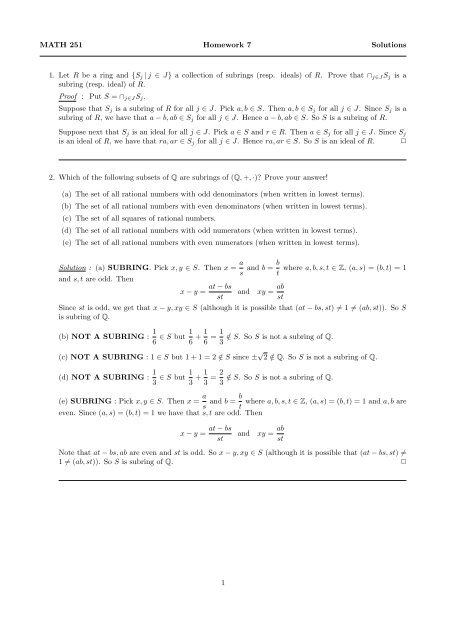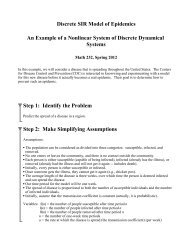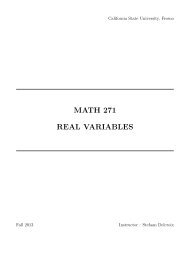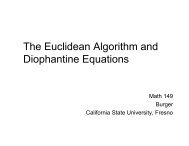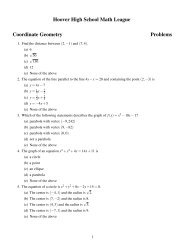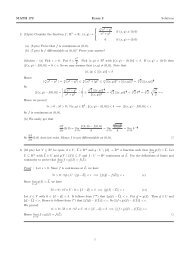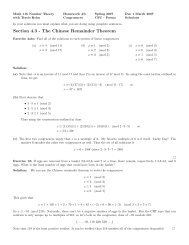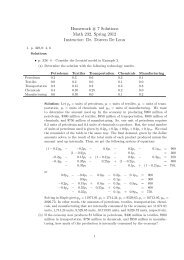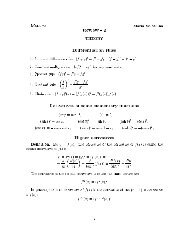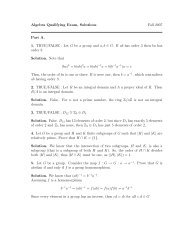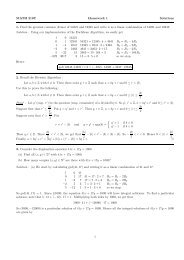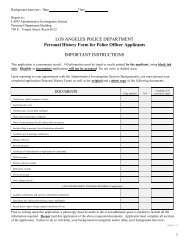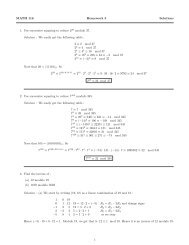MATH 251 Homework 7 Solutions 1. Let R be a ring and {S j | j â J ...
MATH 251 Homework 7 Solutions 1. Let R be a ring and {S j | j â J ...
MATH 251 Homework 7 Solutions 1. Let R be a ring and {S j | j â J ...
You also want an ePaper? Increase the reach of your titles
YUMPU automatically turns print PDFs into web optimized ePapers that Google loves.
<strong>MATH</strong> <strong>251</strong> <strong>Homework</strong> 7 <strong>Solutions</strong><br />
<strong>1.</strong> <strong>Let</strong> R <strong>be</strong> a <strong>ring</strong> <strong>and</strong> {S j | j ∈ J} a collection of sub<strong>ring</strong>s (resp. ideals) of R. Prove that ∩ j∈J S j is a<br />
sub<strong>ring</strong> (resp. ideal) of R.<br />
Proof : Put S = ∩ j∈J S j .<br />
Suppose that S j is a sub<strong>ring</strong> of R for all j ∈ J. Pick a, b ∈ S. Then a, b ∈ S j for all j ∈ J. Since S j is a<br />
sub<strong>ring</strong> of R, we have that a − b, ab ∈ S j for all j ∈ J. Hence a − b, ab ∈ S. So S is a sub<strong>ring</strong> of R.<br />
Suppose next that S j is an ideal for all j ∈ J. Pick a ∈ S <strong>and</strong> r ∈ R. Then a ∈ S j for all j ∈ J. Since S j<br />
is an ideal of R, we have that ra, ar ∈ S j for all j ∈ J. Hence ra, ar ∈ S. So S is an ideal of R. ✷<br />
2. Which of the following subsets of Q are sub<strong>ring</strong>s of (Q, +, ·)? Prove your answer!<br />
(a) The set of all rational num<strong>be</strong>rs with odd denominators (when written in lowest terms).<br />
(b) The set of all rational num<strong>be</strong>rs with even denominators (when written in lowest terms).<br />
(c) The set of all squares of rational num<strong>be</strong>rs.<br />
(d) The set of all rational num<strong>be</strong>rs with odd numerators (when written in lowest terms).<br />
(e) The set of all rational num<strong>be</strong>rs with even numerators (when written in lowest terms).<br />
Solution : (a) SUBRING. Pick x, y ∈ S. Then x = a s <strong>and</strong> b = b where a, b, s, t ∈ Z, (a, s) = (b, t) = 1<br />
t<br />
<strong>and</strong> s, t are odd. Then<br />
at − bs<br />
x − y = <strong>and</strong> xy = ab<br />
st<br />
st<br />
Since st is odd, we get that x − y, xy ∈ S (although it is possible that (at − bs, st) ≠ 1 ≠ (ab, st)). So S<br />
is sub<strong>ring</strong> of Q.<br />
(b) NOT A SUBRING : 1 6 ∈ S but 1 6 + 1 6 = 1 3<br />
/∈ S. So S is not a sub<strong>ring</strong> of Q.<br />
(c) NOT A SUBRING : 1 ∈ S but 1 + 1 = 2 /∈ S since ± √ 2 /∈ Q. So S is not a sub<strong>ring</strong> of Q.<br />
(d) NOT A SUBRING : 1 3 ∈ S but 1 3 + 1 3 = 2 3<br />
/∈ S. So S is not a sub<strong>ring</strong> of Q.<br />
(e) SUBRING : Pick x, y ∈ S. Then x = a s <strong>and</strong> b = b where a, b, s, t ∈ Z, (a, s) = (b, t) = 1 <strong>and</strong> a, b are<br />
t<br />
even. Since (a, s) = (b, t) = 1 we have that s, t are odd. Then<br />
x − y =<br />
at − bs<br />
st<br />
<strong>and</strong><br />
xy = ab<br />
st<br />
Note that at − bs, ab are even <strong>and</strong> st is odd. So x − y, xy ∈ S (although it is possible that (at − bs, st) ≠<br />
1 ≠ (ab, st)). So S is sub<strong>ring</strong> of Q. ✷<br />
1
3. The center of a <strong>ring</strong> R is the set {r ∈ R | ar = ra for all a ∈ R}. Find the center of the quaternions<br />
H = {a + b i + c j + d k | a, b, c, d ∈ R}.<br />
Solution : <strong>Let</strong> a + b i + c j + d k ∈ Z(H). Then<br />
−b + a i + d j + (−c) k = (a + b i + c j + d k) i = i (a + b i + c j + d k) = −b + a i + (−d) j + c k<br />
Hence d = −d <strong>and</strong> −c = c. So c = d = 0. Also<br />
a j + b k = (a + b i) j = j (a + b i) = a j + (−b) k<br />
So b = −b. Hence b = 0. So Z(H) ⊆ R. Clearly, R ⊆ Z(H). Hence Z(H) = R.<br />
✷<br />
4. <strong>Let</strong> R <strong>be</strong> an integral domain.<br />
(a) It is given that R[x] is a commutative <strong>ring</strong> with <strong>1.</strong> Prove that R[x] is an integral domain.<br />
(b) Put I = {x 2 f(x) | f(x) ∈ R[x]}.<br />
(i) Prove that I ✂ R[x].<br />
(ii) Prove that R[x]/I is not an integral domain.<br />
Proof : (a) Suppose that R[x] has zero divisors. Then f(x)g(x) = 0 for some f(x), g(x) ∈ R[x] \ {0}. So<br />
f(x) = a 0 + a 1 x + · · · + a m x m <strong>and</strong> g(x) = b 0 + b 1 x + · · · + b n x n where m, n ≥ 0, a 0 , . . . , a m , b 0 , . . . , b n ∈ R<br />
<strong>and</strong> a m ≠ 0 ≠ b n . Put a i = 0 if i > m <strong>and</strong> b j = 0 if j > n. Then<br />
( i∑<br />
)<br />
a k b i−k<br />
k=0<br />
0 = f(x)g(x) = (a 0 + a 1 x + · · · + a m x m ) (b 0 + b 1 x + · · · + b n x n ) =<br />
Hence a m b n = 0 (the coefficient of x m+n ). Since R has no zero divisors (R is an integral domain), we get<br />
that a m = 0 or b n = 0, a contradiction. Hence R[x] has no zero divisors. So R[x] is an integral domain.<br />
(b) (i) Note that I = {g(x)x 2 | g(x) ∈ R} = (x 2 ). So I ✂ R.<br />
(ii) Note that x ≠ 0 in R[x]/I (since x /∈ (x 2 )) but x · x = x · x = x 2 = 0 in R[x]/I. So x is a zero divisor<br />
of R[x]/I.<br />
✷<br />
m+n<br />
∑<br />
i=0<br />
x i<br />
5. Which of the following subsets of Z[x] are ideals of (Z[x], +, ·) :<br />
(a) The set of all polynomials whose constant term is a multiple of 3.<br />
(b) The set of all polynomials whose coefficient of x 2 is a multiple of 3.<br />
(c) Z[x 2 ] (so the set of polynomials with integral coefficients in which only even powers of x appear).<br />
(d) The set of polynomials whose coefficients sum to zero.<br />
(e) The set of polynomials f(x) with f ′ (0) = 0 where f ′ (x) is the usual derivative of f(x) with respect<br />
to x.<br />
Solution : (a) IDEAL : Note that the constant term of a polynomial p(x) is p(0). Pick f(x), g(x) ∈ S<br />
<strong>and</strong> r(x) ∈ Z[x]. Then<br />
f(0) − g(0) ≡ 0 mod 3 <strong>and</strong> r(0)f(0) ≡ 0 mod 3<br />
So f(x) − g(x), r(x)f(x) ∈ S. Hence S is an ideal of Z[x].<br />
2
(b) NOT AN IDEAL : 3x 2 + x, 3x 2 − x ∈ S but (3x 2 + x)(3x 2 − x) = 9x 4 − x 2 /∈ S. So S is not a<br />
sub<strong>ring</strong> nor an ideal of Z[x].<br />
(c) NOT AN IDEAL : x 2 ∈ Z[x 2 ] <strong>and</strong> x ∈ Z[x]. But x · x 2 = x 3 /∈ Z[x 2 ]. So Z[x 2 ] is not an ideal of<br />
Z[x]. Note that Z[x 2 ] is a sub<strong>ring</strong> of Z[x].<br />
(d) IDEAL : <strong>Let</strong> f(x), g(x) ∈ S <strong>and</strong> h(x) ∈ Z[x]. Note that the sum of the coefficients of a polynomial<br />
p(x) is p(1). So f(1) = g(1) = 0. Then<br />
f(1) − g(1) = 0 <strong>and</strong> h(1)f(1) = 0<br />
So f(x) − g(x), h(x)f(x) ∈ S. Hence S is an ideal of Z[x].<br />
(e) NOT AN IDEAL : x 2 + 1 ∈ S <strong>and</strong> x ∈ Z[x] but x · (x 2 + 1) = x 3 + x /∈ S since (x 3 + x) ′∣ ∣<br />
x=0<br />
=<br />
(3x 2 + 1) ∣ ∣<br />
x=0<br />
= <strong>1.</strong> So S is not an ideal of Z[x]. Note that S is a sub<strong>ring</strong> of Z[x]. ✷<br />
6. <strong>Let</strong> R <strong>be</strong> a commutative <strong>ring</strong> with <strong>1.</strong><br />
(a) <strong>Let</strong> I, J ✂ R with I + J = R. Prove that IJ = I ∩ J.<br />
(b) <strong>Let</strong> I, J, K ✂ R. Prove that (I + J)K = IK + JK.<br />
Proof : (a) <strong>Let</strong> x ∈ IJ. Then x = i 1 j 1 + · · · + i n j n where n > 0, i 1 , . . . , i n ∈ I <strong>and</strong> j 1 , . . . , j n ∈ J. Since<br />
I, J ✂ R, we get that i k j k ∈ I (<strong>be</strong>cause i k ∈ I <strong>and</strong> j k ∈ R) <strong>and</strong> i k j k ∈ J (<strong>be</strong>cause i k ∈ R <strong>and</strong> j k ∈ J) for<br />
k = 1, . . . , n. Since I ∩ J ✂ R, we get that x = i 1 j 1 + · · · + i n j n ∈ I ∩ J. So IJ ⊆ I ∩ J.<br />
Since I + J = R, we have that 1 = x + y for some x ∈ I <strong>and</strong> some y ∈ J. Pick z ∈ I ∩ J. Then<br />
z = z · 1 = z(x + y) = zx + zy = xz + zy. Note that x ∈ I, z ∈ J, z ∈ I <strong>and</strong> y ∈ J. So z ∈ IJ <strong>and</strong><br />
I ∩ J ⊆ IJ.<br />
Hence IJ = I ∩ J.<br />
(b) This property is true if R does not have <strong>1.</strong><br />
<strong>Let</strong> x ∈ (I + J)K Then<br />
x = (i 1 + j 1 )k 1 + · · · + (i n + j n )k n<br />
where n > 0, i 1 , . . . , i n ∈ I, j 1 , . . . , j n ∈ J <strong>and</strong> k 1 , . . . , k n ∈ K. Then<br />
Hence<br />
i 1 k 1 + · · · + i n k n ∈ IK <strong>and</strong> j 1 k 1 + · · · j n k n ∈ JK<br />
x = (i 1 + j 1 )k 1 + · · · + (i n + j n )k n = (i 1 k 1 + · · · + i n k n ) + (j 1 k 1 + · · · j n k n ) ∈ IK + JK<br />
So (I + J)K ⊆ IK + JK.<br />
Since I, J ⊆ I + J, we have that IK, JK ⊆ (I + J)K. Hence IK + JK ⊆ (I + J)K.<br />
Thus IK + JK = (I + J)K.<br />
✷<br />
7. <strong>Let</strong> D <strong>be</strong> an integer such that D is not a perfect square <strong>and</strong> D ≡ 1 mod 4. Put R = Z<br />
{<br />
a + b 1 + √ }<br />
D<br />
: a, b ∈ Z .<br />
2<br />
[<br />
1 + √ ]<br />
D<br />
=<br />
2<br />
3
(a) Prove that R is a <strong>ring</strong> with Z[ √ D] ⊂ R ⊂ Q( √ D). Note that these are proper inclusions!<br />
(b) <strong>Let</strong> N <strong>be</strong> the usual norm on Q( √ D).<br />
• Prove that N(α) ∈ Z for all α ∈ R.<br />
• Find R × (the units of R) if D < 0.<br />
Proof :<br />
(a) Note that<br />
a + b 1 + √ D<br />
2<br />
= a + b 2 + b 2√<br />
D ∈ Q(<br />
√<br />
D) for all a, b ∈ Z<br />
Moreover, if 1 3 = a + b 1+√ D<br />
2<br />
for some a, b ∈ Z then b = 0 <strong>and</strong> a = 1 3 , a contradiction. Hence R ⊂ Q(√ D).<br />
Note that<br />
a + b √ D = (a − b) + (2b) 1 + √ D<br />
∈ R for all a, b ∈ Z<br />
2<br />
Moreover, if 1+√ D<br />
2<br />
= a + b √ D for some a, b ∈ Z then a = 1 2 = b, a contradiction. Hence Z[√ D] ⊂ R.<br />
<strong>Let</strong> α, β ∈ R. Then α = a + b 1+√ D<br />
2<br />
<strong>and</strong> β = c + d 1+√ D<br />
2<br />
for some a, b, c, d ∈ Z. Hence<br />
(<br />
) (<br />
)<br />
αβ =<br />
(<br />
α − β =<br />
a + b 1 + √ D<br />
2<br />
a + b 1 + √ D<br />
2<br />
) (<br />
−<br />
c + d 1 + √ D<br />
2<br />
c + d 1 + √ D<br />
2<br />
since D ≡ 1 mod 4. Hence R is a sub<strong>ring</strong> of Q( √ D).<br />
(b) • <strong>Let</strong> a, b ∈ Z. Then<br />
(<br />
N a + b 1 + √ )<br />
D<br />
= N<br />
2<br />
since D ≡ 1 mod 4.<br />
)<br />
=<br />
= (a − c) + (b − d) 1 + √ D<br />
2<br />
∈ R<br />
(<br />
ac + bd D − 1 )<br />
(<br />
1 + √ )<br />
D<br />
+ (ad + bc + bd)<br />
∈ R<br />
4<br />
2<br />
((<br />
a + b )<br />
+ b ) (<br />
√<br />
D = a + b 2 ( ) 2 b<br />
− D = a<br />
2 2<br />
2) 2 + ab + b 2 1 − D ∈ Z<br />
2<br />
4<br />
• Suppose that D < 0. For a, b ∈ Z, we have that<br />
a+b 1 + √ (<br />
D<br />
∈ R × ⇐⇒ N a + b 1 + √ )<br />
D<br />
= ±1 ⇐⇒<br />
2<br />
2<br />
(<br />
a + b ) 2<br />
−D b2<br />
2 4 = ±1 ⇐⇒ a2 +ab+b 2 1 − D = 1<br />
4<br />
If b 2 = 0 then a 2 = 1 <strong>and</strong> so (a, b) ∈ {(−1, 0), (1, 0)}. So suppose that b 2 ≠ 0. Then |D|b 2 ≤ 4. Since<br />
D ≡ 1 mod 4, this is only possible if D = −3 <strong>and</strong> b 2 = <strong>1.</strong> If b = 1 then a 2 + a + 1 = 1 <strong>and</strong> so a ∈ {−1, 0};<br />
if b = −1 then a 2 − a + 1 = 1 <strong>and</strong> so a ∈ {0, 1}.<br />
⎧ {<br />
⎪⎨<br />
R × =<br />
⎪⎩<br />
1, −1, −1 + √ −3<br />
2<br />
, 1 + √ −3<br />
2<br />
, − 1 + √ −3<br />
, 1 − √ }<br />
−3<br />
2 2<br />
if D = −3<br />
{1, −1} if D < −3<br />
4
8. Find all <strong>ring</strong> homomorphisms ϕ : Q → Q.<br />
Solution : Since ϕ is a <strong>ring</strong> homomorphism, we get that<br />
So ϕ(1) is a solution of x 2 = x. Hence ϕ(1) ∈ {0, 1}.<br />
ϕ(1) = ϕ(1 · 1) = ϕ(1) · ϕ(1)<br />
Suppose first that ϕ(1) = 0. So {0} ̸= Ker ϕ ✂ Q. But Q has only two ideals since Q is a field. So<br />
Ker ϕ = Q. Hence ϕ(x) = 0 for all x ∈ Q.<br />
Suppose next that ϕ(1) = <strong>1.</strong> <strong>Let</strong> n ∈ N 0 . Since ϕ is a <strong>ring</strong> homomorphism, we have that<br />
ϕ(n) = ϕ(1 + 1 + · · · + 1) = ϕ(1) + ϕ(1) + · · · + ϕ(1) = n ϕ(1) = n<br />
} {{ } } {{ }<br />
n times<br />
n times<br />
Since ϕ is a group homomorphism from (Q, +) to (Q, +), we get that ϕ(−n) = −ϕ(n) = −n.<br />
ϕ(0) = 0, we proved that ϕ(m) = m for all m ∈ Z.<br />
Pick q ∈ Q. Then q = m n<br />
So ϕ(q) = m n = q.<br />
Since<br />
for some m ∈ Z <strong>and</strong> some n ∈ N 0. Since ϕ is a <strong>ring</strong> homomorphism, we get that<br />
(<br />
m = ϕ(m) = ϕ n · m )<br />
n<br />
( m<br />
)<br />
= ϕ(n) ϕ = n ϕ(q)<br />
n<br />
We proved that there are only two possible <strong>ring</strong> homomorphisms from Q to Q :<br />
ϕ 1 : Q → Q : x → 0 <strong>and</strong> ϕ 2 : Q → Q : x → x<br />
One easily checks that ϕ 1 <strong>and</strong> ϕ 2 are indeed <strong>ring</strong> homomorphisms.<br />
✷<br />
5


